In this article, you will learn What is Refrigeration? Its components, working, advantages, applications, and types of refrigeration are explained with diagrams.
Furthermore, you can also download the PDF file of this article at the end.
What is Refrigeration?
Refrigeration is defined as the process of achieving and maintaining a temperature below ambient, with the aim of cooling a product or space to the required temperature. It is also defined as artificial cooling.
Generally, refrigeration is the action of cooling, and in practice, this requires the removal of heat and discarding it at a higher temperature. Therefore, refrigeration is the device of moving heat from a lower temperature to a higher temperature.
In addition to cooling applications, refrigeration is utilized in air conditioning and heat pumps. The basic principles are those of physics and thermodynamics, and these principles apply to all applications.
One of the most famous applications of refrigeration is the protection of perishable food products by storing them at low temperatures. Refrigeration systems are also widely used to provide thermal comfort to humans through air conditioning.
Read Also: List of Important Terms Used In Thermodynamics
Overview
Air conditioning refers to the treatment of air in order to control its temperature, moisture content, cleanliness, odor, and circulation, as required by the occupants of the space, a process, or products simultaneously.
The name of refrigeration and air conditioning evolved from the human need for food and comfort and has a centuries-old history. The history of refrigeration is very interesting as its aspects, availability of refrigeration, developments in prime movers and compressors, and the method of refrigeration are part of it.
How Refrigeration Works?
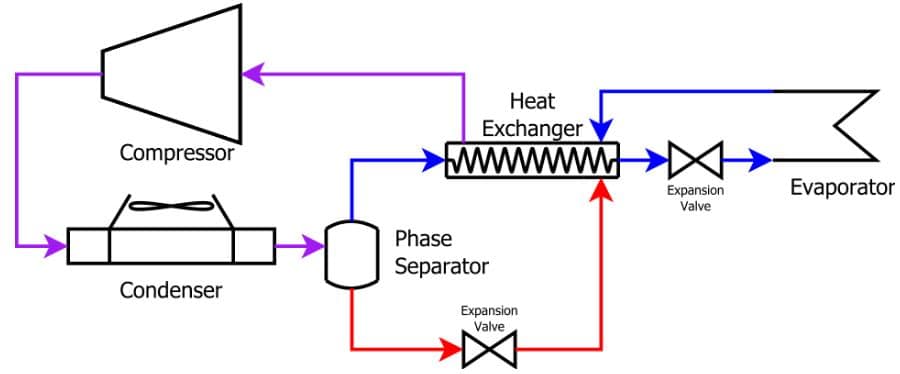
The refrigerator is the machine that is used to extract heat from a body low temperature and then rejects this heat to a high-temperature body. If the main purpose of the machine is to cool some object, the machine is named a refrigerator.
According to the second law of thermodynamics (Clausius statement), heat does not flow from a low-temperature body to a high-temperature body without the aid of external work. Hence external work is required to drive a refrigerator.
A heat engine can be operated in a reversible cycle with the aid of an external source. In this cycle, heat is drawn from the cold body and rejected to a hot body. Hence the engine is called a heat pump.
In the refrigerator also, heat is drawn from the cold body and rejected to the hot body. Thus, the refrigerator operates on the reversed heat engine cycle.
Read Also: What are the different types of engines? Explained with Pictures
Types of Refrigeration:
Following are the types of refrigeration are explained below:
- Mechanical compression refrigeration
- Evaporative cooling
- Absorption refrigeration
- Thermoelectric refrigeration
- Vapour compression refrigeration
- Vapour absorption refrigeration
#1 Mechanical Compression Refrigeration
Mechanical compression refrigeration systems are commonly used for commercial and industrial refrigeration as well as air conditioning. In these types of refrigeration systems, the refrigerant vapour is compressed by means of a centrifugal, screw, or reciprocating compressor.
Mechanical refrigeration systems have high power consumption for the compressor and pumps needed for the cooling water circuit. After compression, the vapour passes to a condenser where it condenses, this vapour is then expanded in an expansion valve and gives a cooling effect.
#2 Evaporative Cooling
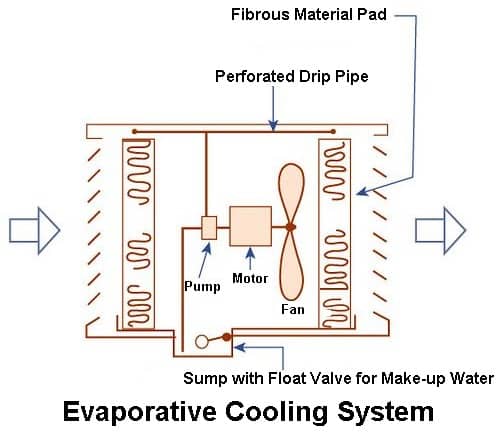
Evaporative cooling systems use water to cool the air brought in from outside the home. Water is pumped onto the pad through which air passes, and the air loses its heat from the water, this process is known as evaporative cooling. Then electrical power is supplied to the pumps and blower fans.
An evaporative cooling system is easier than an air conditioner-based refrigerant because it takes less power to cool the air. It also has the benefit of bringing fresh air and increasing humidity in dry conditions.
#3 Absorption Refrigeration
Absorption refrigeration is a system that uses a heat source (which may be solar power or a fossil-fueled flame) to provide the energy needed to run the cooling process. It uses two types of coolant, the first coolant performs evaporative cooling and is then absorbed into the second coolant.
Now, heat is required to reset the two coolants to their primary state. This principle also is used to air-condition buildings using waste heat from gas turbines or water heaters. Absorption refrigeration systems are commonly used in recreational vehicles, campers, and caravans.
#4 Thermoelectric Refrigeration
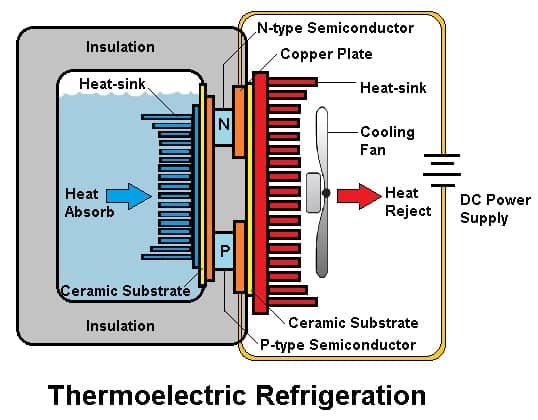
The thermoelectric refrigeration system normally works on the principle of the Peltier effect. This effect makes a variation in temperature by transferring heat between the two conductor junctions. A voltage is applied between the connected conductors to produce an electric current.
When current passes through the junctions of two conductors, heat is eliminated at one junction and cooling occurs. Now, heat is collected at the second junction. However, practically the main application of the Peltier effect is cooling. It can also be used as a temperature controller which can be either hot or cold.
#11 Vapour Refrigeration
The working agents employed n these types are vapours like ammonia, carbon dioxide, sulfur dioxide, Freons, etc.
The vapour refrigerations can be further classified as:
- Vapour compression refrigerations
- Vapour absorption refrigerations
1. Vapour Compression Refrigeration (VCR)
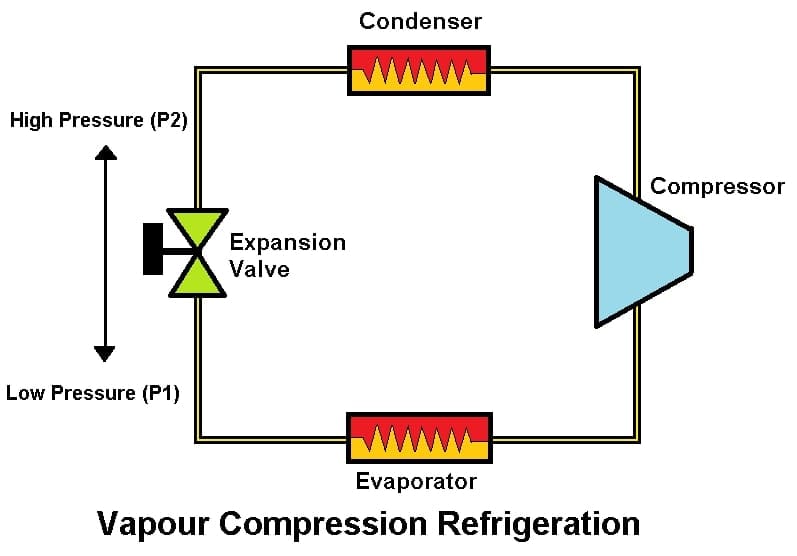
This type of refrigeration uses a liquid refrigerant in a closed system that circulates the refrigerant through four stages in which it is compressed and expanded to alternate between vapor and liquid form without leaving the refrigerating area.
During the evaporation process, it absorbs heat from the cold body and this heat is used as its latent heat to convert from liquid to vapour. In condensing process, the heat is rejected to external bodies, thus creating a cooling effect in the working fluid.
This method is widely used for the air conditioning of buildings and automobiles. Moreover, oil refineries, chemical processing plants, and natural gas processing plants are types of industrial plants that often use vapor-compression refrigeration systems.
2. Vapour Absorption Refrigeration (VAR)
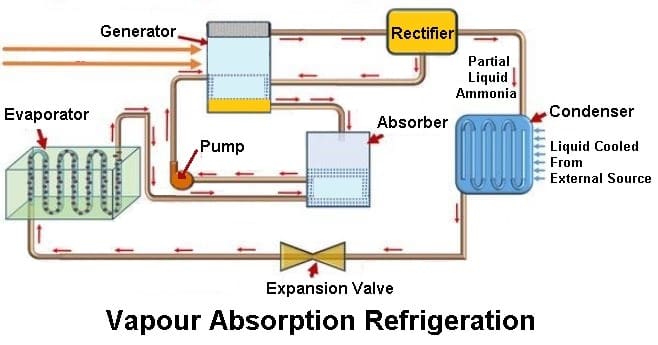
These types of refrigeration consist of evaporators, absorbers, generators, condensers, expansion valves, pumps, and reducing valves. Vapour absorption refrigeration systems (VARS) are primarily used where high power is not readily available.
VAR systems use water-lithium bromide sets are used extensively in large-capacity air conditioning systems. In these systems, water is used as the refrigerant and a solution of lithium bromide in water is used as the absorbent.
Vapour absorption refrigeration systems use heat energy for refrigeration which is less expensive to produce than VCR systems. VAR systems are suitable for locations where heat energy is available at a low cost. These are widely used in steam power plants.
Read Also: What are the different types of Cooling Systems In Automobile (PDF)
Methods of Refrigeration
- Ice refrigeration
- Dry ice refrigeration
- Steam jet refrigeration
- Throttling refrigeration
- Liquid refrigeration
- Air refrigeration
#1 Ice refrigeration
The ice is kept in the cabinet of refrigerators and this acts as the refrigerating means. Ice was used to refrigerate and thus preserve food. For centuries, the seasonal collection of snow and ice was a regular practice of most ancient cultures: the Chinese, Greeks, Romans, and Persians.
Snow and ice were placed in caves with straw or other insulating material and the Persians stored the ice in a pit. Ice rationing allowed the preservation of foods in warmer periods.
Ice has its own effectiveness as a cooling agent to a melting point of 0 °C (32 °F) at sea level. To melt, ice needs to absorb 333.55 KJ/kg of heat. The foods kept near this temperature have an extended storage life.
#2 Dry Ice Refrigeration
In non-cyclic refrigeration, dry ice (frozen carbon dioxide) is cooled by melting it upwards. The dry ice refrigeration system is used for small purpose applications such as in laboratories, workshops, or portable coolers.
Solid carbon dioxide has no liquid state at normal atmospheric pressure and it directly passes from solid to vapour state at temperatures of -78.5 °C (-109.3 °F). It is effective for maintaining products at low temperatures during sublimation. Such systems where the refrigerant evaporates and goes into the atmosphere are known as “total loss refrigeration”.
#3 Steam Jet Refrigeration
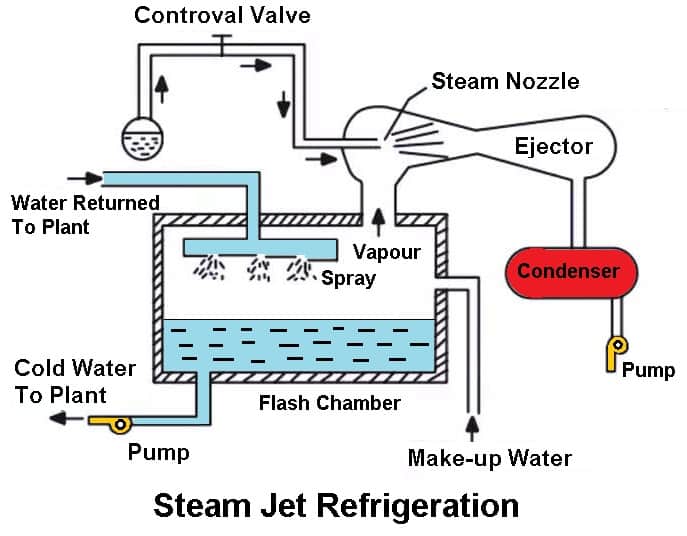
In this system, steam is passed through a high-efficiency vacuum ejector to exhaust a separate, closed vessel that forms part of a cooling water circuit. The partial vacuum in the closed vessel evaporates the water, thus releasing the heat through evaporative cooling.
The cooled water is now pumped through the circuit to the air cooler, while the evaporated water from the ejector is collected in a separate condenser and then is returned to the cooling circuit.
#4 Throttling refrigeration
The throttling effect is associated with the refrigeration system. It is simply the process of reducing the pressure of the liquid refrigerant as it passes through the expansion device. By reducing the pressure, which makes the liquid refrigerant flash into a vapour, creating a cooling effect.
#5 Liquid Nitrogen Refrigeration
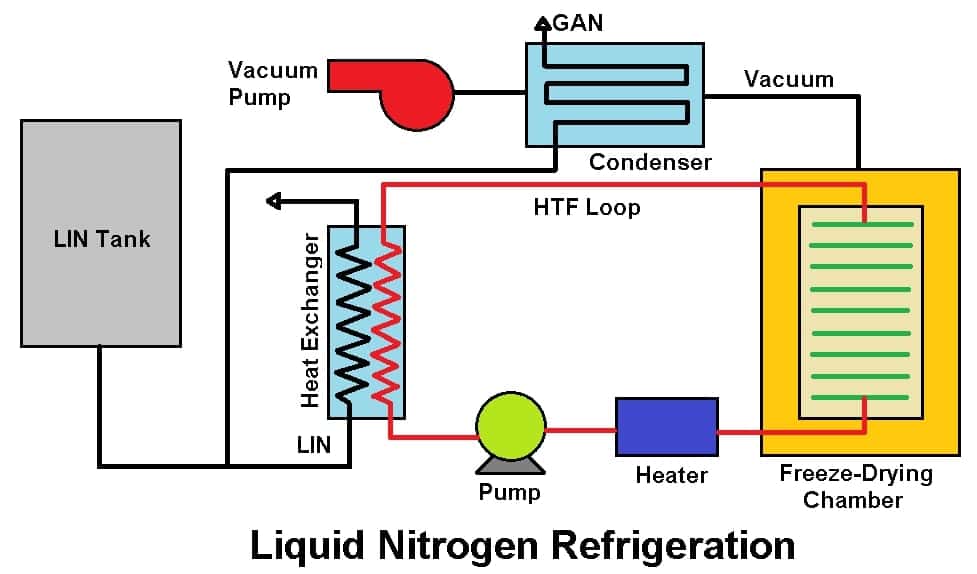
As liquid nitrogen boils at -196 °C, far below the freezing point of water, it is valuable as an extreme coolant for the short overclocking session. Evaporation designs ranging from cut-out heat sinks with pipes attached to copper containers are used to capture nitrogen as well as prevent large temperature changes.
However, after the nitrogen has evaporated, it has to be replaced. In a typical installation of liquid a nitrogen cooling. A copper or aluminum pipes are mounted on top of the processor or graphics card. After being heavily insulated against condensation, liquid nitrogen is discharged into the pipe, resulting in a temperature drop of 100 °C.
#6 Air refrigeration
The air refrigeration systems use air as their refrigerant, which compresses and expands to create heating and cooling capacity.
Air cycle use is one of these, providing a good alternative to CFC refrigerants as well as low energy consumption and capital cost for selected applications. These types of refrigeration systems are commonly used for scientific, industrial, and commercial purposes.
Application of Refrigeration
The following are the main application of refrigeration:
- The refrigeration systems are commonly seen In chemical industries for separating and liquefying gases and vapours.
- These are well suitable for manufacturing ice.
- The primary use of refrigeration is for the preservation of perishable foods in cold storage.
- If it is necessary to cool the water, a refrigeration system is used.
- Used for controlling the humidity of air in the manufacture and heat treatment of steels.
- For chilling the oil to remove wax in oil refineries.
- For the preservation of oof tablets and medicines in pharmaceutical industries.
- They are also used for the preservation of blood, medical fields, tissues etc. in medical fields.
- For comfort air conditioning in hospitals, theatres etc.
Advantages of Refrigeration System
- In most cases, the air is used as a refrigerant, which is readily available and inexpensive.
- The design and manufacture of refrigeration systems are simple, there are no complicated parts, and the maintenance cost is low.
- The refrigerant used is non-toxic, non-flammable, non-corrosive.
- There will be no significant change in the performance of the refrigeration system if it is operated far beyond its design conditions.
- They can cause a large temperature difference between hot and cold regions. So the same system is used for both cooling and heating effect.
Disadvantages of Refrigeration System
- The refrigeration system has a lower coefficient of performance than other refrigeration cycles.
- The Working cost of the refrigeration system is quite high.
- The components of this system are heavy with large space.
- The air contains pollutants, so clean the air filter regularly in open systems.
Wrapping It Up
As I said above, refrigeration systems have two components, one for frozen items and another for items that need refrigeration but are not frozen. It can dissipate all the heat from the load inside the containers and make them cooler and provide longer-lasting life.
So for now, I hope that you have learned about the “Types of Refrigeration“. If you have any questions or doubts about this article, feel free to ask in the comments. If you got this article helpful, please share it with your friends.
Want free PDFs in your inbox? Then subscribe to our newsletter.
Download PDF of this article:
You might like to explore more in our blog:
- What are the different types of Heat Exchanger? [PDF]
- What is Air Cooling System and How It Works In Vehicle? PDF
- 6 Most Common Problems In Cooling System of the Engine [Fix Them Now]
- How Steam Engine Works? It’s Parts, Types, Uses, and More
Other Links:
Thanks for helping me understand the advantages of the refrigeration system and its two components, frozen and non-frozen refrigeration. As we all know, perishable items in the food industry must be stored in proper coolrooms or freezers. This article helps choose the right mobile freezer needed in the food business.
I appreciate your comment. You’re welcome.
Nice lecture there , thanks a lot
You’re welcome.
Wow. Nice explanation, thank you so much ,❤️❤️❤️
You’re most welcome.